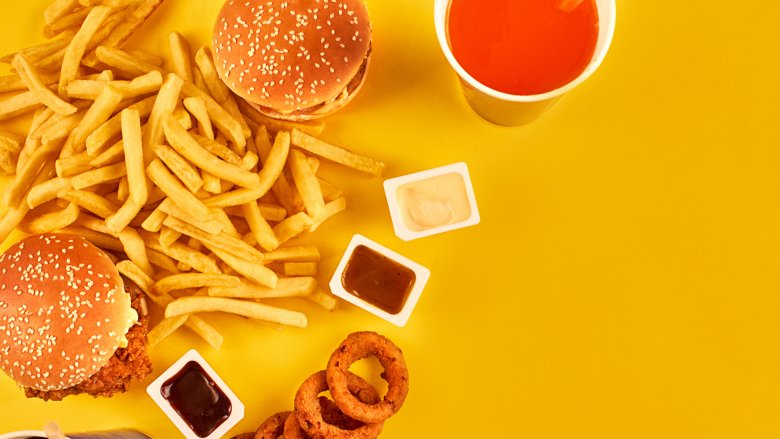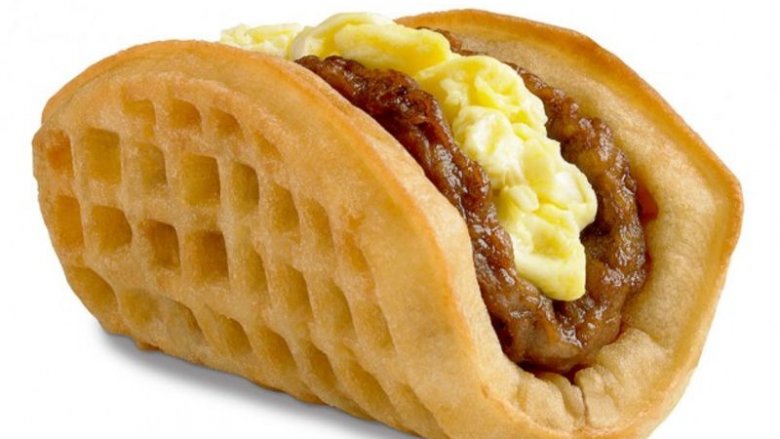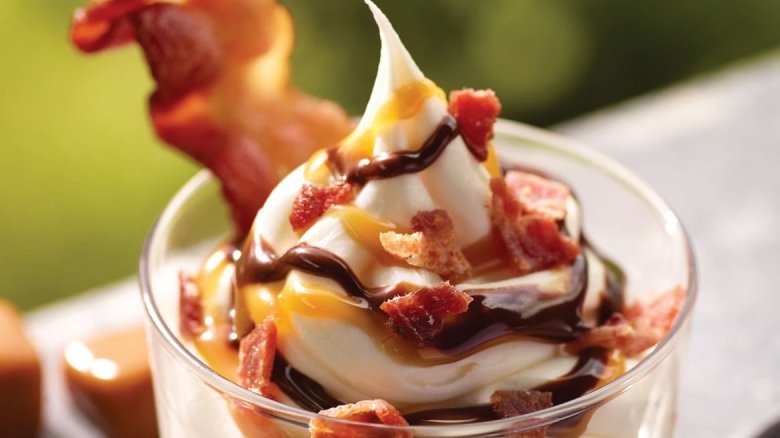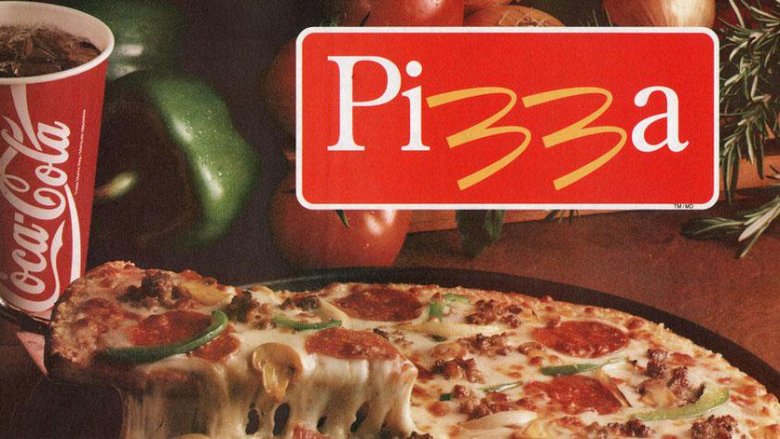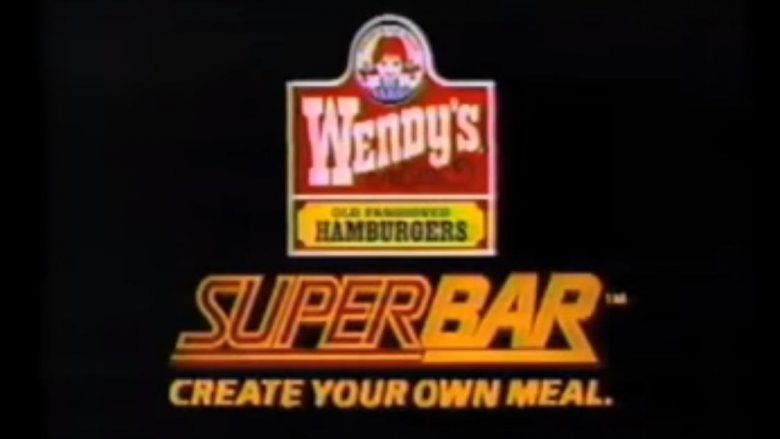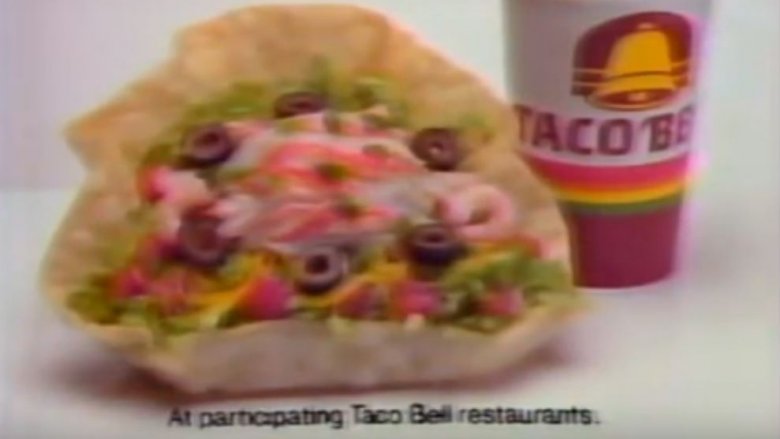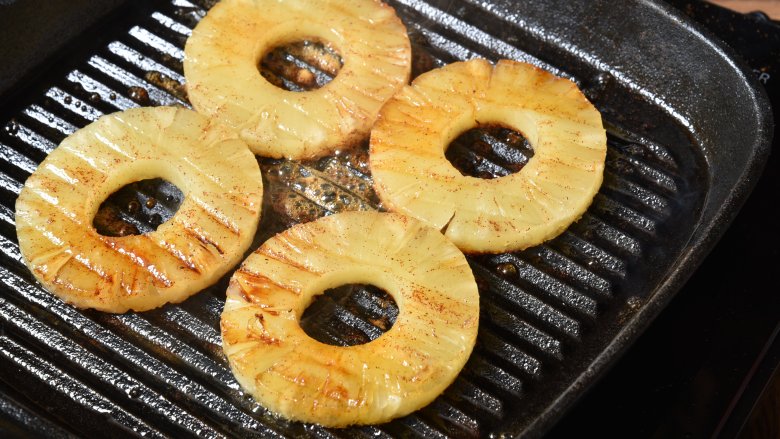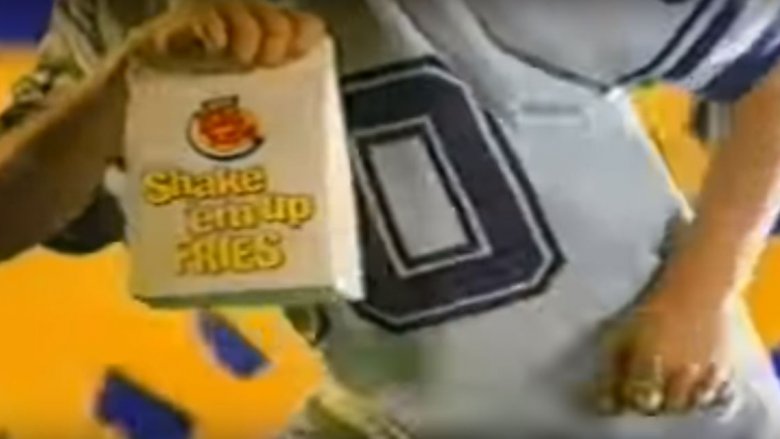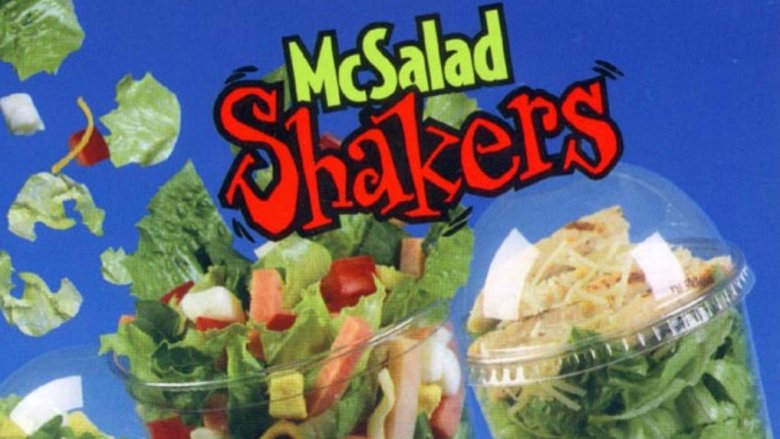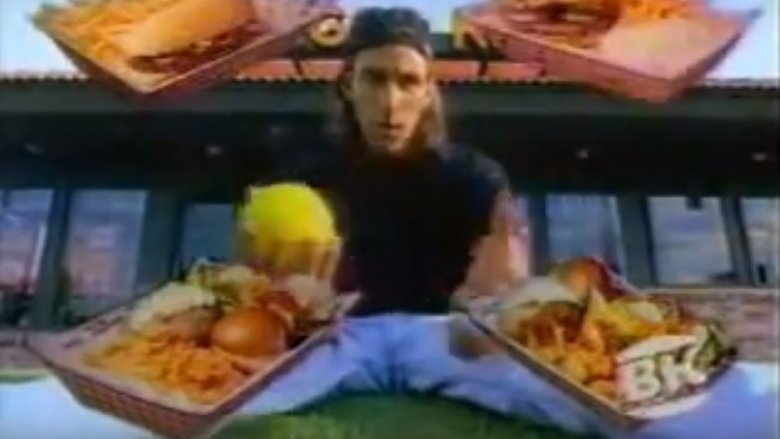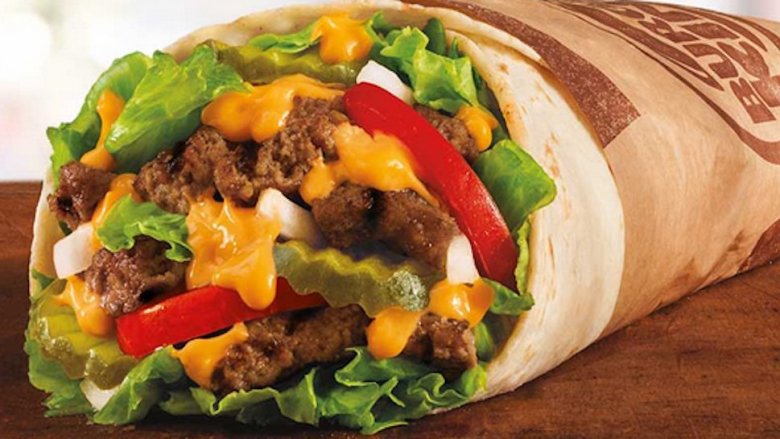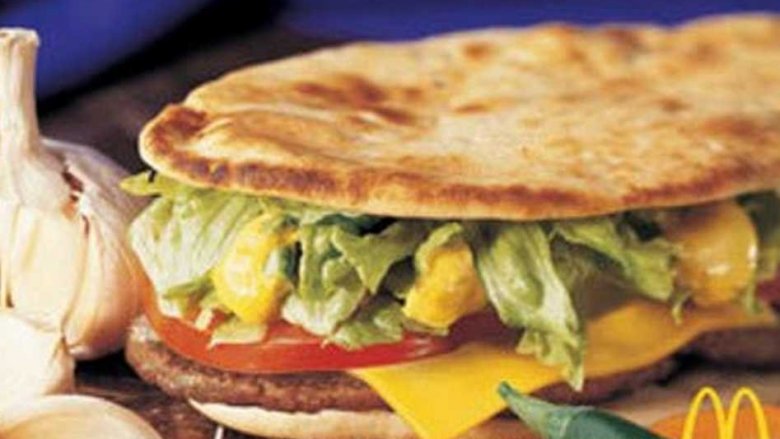The Most Bizarre Discontinued Fast Food Items You Totally Forgot About
Once upon a time in 1972, a well-known fast food franchise released a breakfast sandwich known as "The Egg McMuffin." An inspired combination of egg, bacon, and cheese on a toasted English muffin, the Egg McMuffin was not only a huge success, it arguably spearheaded the entire fast food breakfast market.
But sadly, not every fast food invention is an Egg McMuffin.
Your average fast food chain relies on a team of culinary professionals to come up with new ideas. Sometimes, they dream up timeless tasty gems like the In-N-Out Double Double or the McDonald's McRibs. Other times, they dream up weird, forgettable, and just plain gross concoctions that quietly disappear from their menus forever, never to torture another taste bud again.
At the risk of reawakening unpleasant memories and tummy aches, here are some of the most bizarre discontinued fast foods you totally forgot about:
Taco Bell's Waffle Taco
Taco Bell, a self-proclaimed "outside the bun" kind of company, wasn't about to let McDonald's steal all the breakfast glory with its Egg McMuffin. Joining in on what some dubbed the fast food "breakfast wars," Taco Bell rolled out its first ever breakfast menu in 2014. Along with standards like breakfast burritos, the Taco Bell morning menu included a strange new beast called the Waffle Taco. As its name suggests, the Waffle Taco consisted of a taco-shaped waffle packed with breakfast taco fillings—eggs and meat—and served with syrup on the side.
Although fellow breakfast items like the A.M. Crunchwrap (now called the Breakfast Crunchwrap) were a hit for Taco Bell, the Waffle Taco was a miss. Soon after its debut, Taco Bell Chief Marketing Officer Chris Brandt hinted that some items "might run out of gas." Sure enough, the Waffle Taco was taken off the menu in 2015 and replaced with the Biscuit Taco. The Biscuit Taco followed the same basic formula (with a biscuit in place of a waffle shell) and—surprise!—it's also no longer on the menu.
Burger King's Bacon Sundae
Taking a cue from the bacon-as-dessert fad that gripped the United States in the 2000's, Burger King introduced a special-edition bacon sundae in the summer of 2012. After being tested out in Nashville, Tennessee, the sundae was met with mixed reviews and fierce debate when it was made available nationwide. Fans called it "crunchy and smoky" and appreciated its generosity on the bacon. NPR wondered if it was brilliant or tragic, while the Atlantic found it downright offensive.
You be the judge: Picture a sundae with vanilla soft-serve ice cream drizzled with chocolate fudge and caramel. Then, imagine that sundae is topped with real bacon crumbles and finished off with an entire strip or two of bacon. If that mental image does it for you, we're sorry to report that you're out of luck, since the limited-edition sundae never made it past that blessed summer. But, since Burger King does still offer sundaes with caramel and chocolate fudge, you could technically DIY your own by ordering a sundae with a couple of sides of bacon and crumbling them in there yourself.
McDonald's Pizza
Although it was already the world's biggest name in burgers by the 1980s, McDonald's wanted more. The pizza industry was booming, and the fast food empire was hungry for a slice of the pie.
Thus began McDonald's quest to develop its own pizza. After calzone-shaped pizzas and mini pies flopped regionally, the chain decided to release a traditional, full-size, circular pizza. The McDonald's team of fast food scientists even invented a quick-cook oven that baked up the frozen pies in under six minutes. In 1989, McDonald's began testing out their pies, expanding to 40 percent of restaurants nationwide by the early '90s.
So what went wrong? For starters, in order to accommodate the new pies, McDonald's restaurants across the country would have to widen drive-thru windows and expand kitchens to make room for the ovens. Secondly, even with ultra-fast ovens, pizzas took longer to cook than many customers were willing to wait for fast food. And finally, at $5.99 to $8.99 per pie, the pizzas cost more than people were used to spending at the Golden Arches.
McDonald's pizzas didn't make it past the '90s at most franchises. Two rogue McDonald's locations in Ohio and West Virginia still served the fabled pies long after they were discontinued, though they finally came off the menu in August 2017.
Wendy's Superbar
Unlike many of the other items on this list, Wendy's Superbar didn't die because it was a flop—it failed because it was too much of a hit.
For a brief, wondrous period during the late '80s and '90s, Wendy's offered an all-you-can-eat buffet with salad, fruit, and "Mexican Fiesta" and "Pasta Pasta" stations known as the Superbar. The Mexican Fiesta portion was a taco bar with taco fixings and meat of questionable origins. The cleverly named "Pasta Pasta" station featured different types of spaghetti and sauces, along with breadsticks. There was even a dessert area with chocolate and vanilla pudding. And you could load up your tray as many times as you wanted for the low, low price of $2.99 at most locations.
Because the Superbar was such a success, employees struggled to keep the buffet cleaned and stocked as customers took full advantage of the all-you-can-eat policy. The last Wendy's Superbar was closed down in 1998, leaving only wonderful memories of overcooked taco meat and lukewarm pudding in its wake.
Taco Bell's Seafood Salad
There's something fishy about seafood served up via a drive-thru — at least when it hasn't been breaded and fried. Taco Bell didn't see it this way, apparently, because it thought it would be a good idea to release a Seafood Salad in the 1980s to compete with McDonald's Filet-O-Fish.
The Taco Bell Seafood Salad was a blend of lettuce, tomatoes, and olives showered with "tender" bay shrimp and a mix of snow crab and white fish. The dish was among Taco Bell's earlier attempts to offer meat-free and "healthy" alternatives. Because fish = healthy, duh, even if it's buried in taco cheese and served in a fried taco shell.
Taco Bell's super old-school '80s seafood salad commercial takes a jab at McDonald's Filet-O-Fish, asking "why order fish if it ends up looking like a burger?" and touting the Seafood Salad as a "refreshing change from anything on a bun." Despite their best marketing efforts, the Taco Bell Seafood Salad was short-lived, while McDonald's Filet-O-Fish lives on.
McDonald's Hula Burger
Like we said: for all our objections to fast-food seafood, the Filet-O-Fish has managed to withstand the taste tests of time. In fact, McDonald's reps claim that the fish sandwich is the most popular item on their menu during March, when many Christians give up meat in observance of Lent.
But the sandwich wasn't popular with everyone at first — particularly McDonald's founder, Ray Kroc. "You're always coming up here with a bunch of crap!" Kroc reportedly told the franchise owner who proposed the idea for the Filet-O-Fish. "I don't want my stores stunk up with the smell of fish."
Kroc, in fact, had another idea for attracting Catholic customers during lent: the Hula Burger. This Hawaiian-inspired sandwich consisted of a grilled pineapple slice, cheese, and a bun. On Good Friday in 1962, Kroc agreed to release the Filet-O-Fish in conjunction with his Hula Burger in select restaurants. Whichever sandwich was most popular would win a spot on McDonald's permanent menu.
On that day, 350 Filet-O-Fish sandwiches were sold. The number of Hula Burgers sold? About six. In Kroc's biography, Grinding it Out: The Making of McDonald's, he mentioned one customer observed, "I like the hula, but where's the burger?" And so, we said aloha to the Hula Burger nearly right after we'd said aloha.
Burger King's BK Shake 'Em Up Fries
If you subscribe to the school of thought that cheese makes everything better, you may have been down with Burger King's DIY cheesy fries. BK Shake 'Em Up Fries were elegant in their simplicity: the fries came in a paper bag along with a packet of "Cheezy Flavor Blast" (that's cheesy with a "z"). You sprinkled the cheese powder into the bag, then shook it like a Polaroid picture.
In commercials advertising BK Shake 'Em Up Fries, the company encouraged diners to try out different fry-shaking techniques, including:
-
The jackhammer shake. This involved holding the bag directly in front of you and shaking it up and down. Curiously, the move resembles neither a jackhammer nor the jackhammer wrestling move.
-
The helicopter shake. To do the helicopter shake, you clenched the bag in one hand, then spun around with both your arms outstretched. Like a helicopter.
-
The boogie shake. For this one, just grab that bag and shake your groove thang.
But in the end, demanding any kind of physical exertion in order to eat cheese fries proved to be asking too much and the Shake 'Em Up Fries, too, went way of the Bacon Sundae.
McDonald's McSalad Shakers
Speaking of fast food items that came with an upper-body workout, the McSalad Shaker was an aptly named McDonald's invention that required a good shaking. The salad was packed into a tall, clear cup so you could gaze upon all the healthy ingredients within while fellow customers looked on enviously, cursing their lack of discipline and ruing their own decision to order fattening fries. You'd pour in your choice of dressing, pop on the domed lid, and shake, shake, shake, señora . "The revolutionary packaging concept makes eating a McSalad Shaker easy and fun," insisted McDonald's president Alan Feldman in a press release.
McSalad Shakers came in three varieties: Chef, Grilled Chicken Caesar, and Garden. Today, you can still get salads at McDonald's, but they're served in a boring ol' bowl. Do they taste the same? Basically. Do they require less cardio? If you're doing it right. Is the experience of eating a salad at McDonald's now a little less like being a star maraca player in a mariachi band? Yes.
Burger King's Dinner Baskets
In 1992, Burger King bravely embarked on a bold experiment. In an effort to transform "change the way people think about fast food," Burger King began offering dinnertime table service like a fancypants sit-down restaurant.
Every evening from 4 p.m. to 8 p.m., customers could place orders and then take a seat at a table, where waiters would deliver their meals along with plasticware, napkins, and condiments. As diners waited, they could chow down on free popcorn while their youngsters scribbled with crayons on tray-liners. As part of its elaborate dinner experiment, Burger King dished out Dinner Basket entrees like steak sandwiches, chicken filet, and fried shrimp, served with a choice of fries or baked potatoes and salad or coleslaw. All this for as little as $2.99.
So confident was Burger King in their daring dinner service quest, they invested heavily in its marketing campaign. They hired actor Dan Cortese from MTV Sports to yell "I love this place!" at the camera amid frenetic music in a series of frighteningly adrenalized commercials. Alas, their lofty Dinner Basket dream never took off, and Burger King quickly retired its table service and chucked its spokesperson, hoping never to speak of the debacle again. We're only preserving its memory as a warning to prevent future generations from making our forefathers' same fast food mistakes.
Burger King's Whopperito
Here's a common scenario: It's late at night, and you and your friends are coming home from a bar or a party. You'll need large quantities of cheap, meaty food you will probably regret in the morning, pronto. At this hour, your options are fast food burgers or late-night Mexican. Which do you choose?
With drunk-and-or-stoned late-night diners divided, Burger King decided to take drastic measures to pull ahead of the Mexican and Tex-Mex competitors. So in 2016, it created the Whopperito: a Frankensteined fusion of burger and burrito. The monstrosity was essentially a Whopper, but served in a tortilla instead of a bun and slathered in a proprietary queso sauce instead of ketchup and mayo.
Predictably, the Whopperito was denounced by food critics, aside from Fox News, who claimed its tasters found it "delightful" and remarked, "I like that it's in a wrap. It's cute. It's handheld." Thanks, Fox News.
The Whopperito lasted a few months as a limited-release item before BK came to its senses and removed it from the menu.
McDonald's McAfrika
This didn't happen in the US, but it certainly made the news here. The year was 2002 when McDonald's released a special edition sandwich called "McAfrika" into its Norway restaurants. Allegedly made from an "authentic African recipe," the sandwich featured beef, cheese, tomatoes, and pita bread. OK, sure. While a bit of a stretch and kind of culturally insensitive, it seems like basically a innocent idea, right?
But here's the thing: Unfortunately for McDonald's, the launch of the McAfrika happened just as a major famine hit southern Africa. The sandwich sparked outrage, with many pointing to the cruel irony of naming a greasy burger after a continent where millions were dying of starvation. Protesters from the Norwegian Church Aid even went as far as standing outside McDonald's and handing out "catastrophe crackers," the high-energy biscuits distributed to victims of starvation in Africa.
McDonald's representatives acknowledged the poor timing, but didn't agree to immediately withdraw the sandwich from restaurants. The company did offer to allow humanitarian groups to set up collection boxes and informational posters in locations that sold the burger, however.
